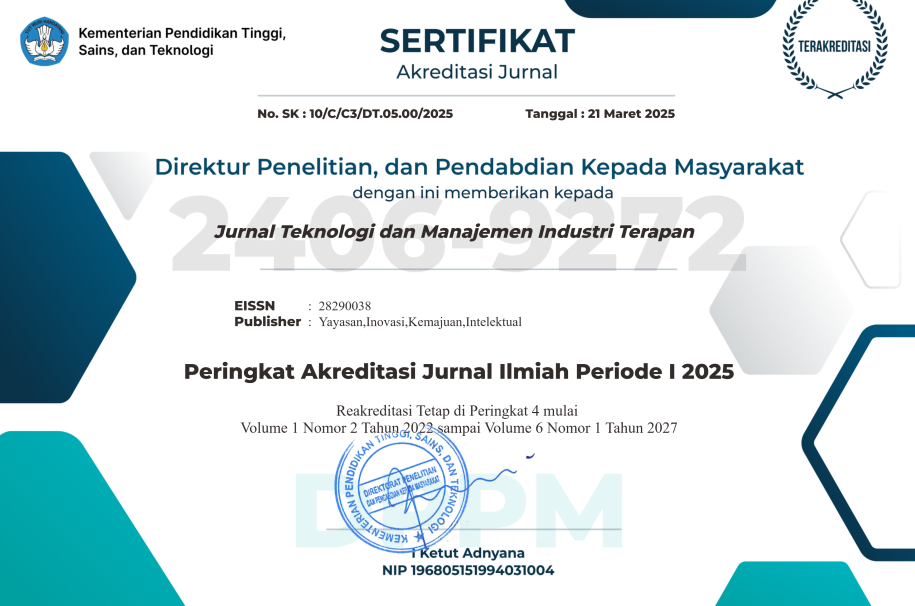Risiko Ergonomi, Karakteristik Penjahit, Dan Keluhan Musculoskeletal Disorders (MSDS) Pada Penjahit Di Tanjungpinang Kota
DOI:
https://doi.org/10.55826/jtmit.v3i3.479Keywords:
Ergonomi, Kesehatan kerja, RULA, NBM, MSDs, PenjahitAbstract
Aktivitas menjahit yang melibatkan postur tubuh yang statis, gerakan tangan berulang, dan penggunaan peralatan yang tidak ergonomis meningkatkan risiko MSDs seperti nyeri otot dan sendi. Penelitian ini mengeksplorasi gambaran risiko ergonomi, karakteristik penjahit, dan keluhan MSDs di Tanjungpinang Kota. Penelitian ini menggunakan metode deskriptif kualitatif dengan instrumen Rapid Upper Limb Assessment (RULA) untuk menilai risiko ergonomi, Nordic Body Map (NBM) untuk keluhan MSDs, dan kuesioner untuk karakteristik penjahit. Hasil penelitian menunjukkan hanya 3,33% penjahit memiliki postur kerja yang masih dapat diterima, sedangkan 56,67% berada dalam kategori yang memerlukan investigasi lebih lanjut dan 40% memerlukan perubahan segera. Dari 30 penjahit yang diteliti, 2 orang (6,67%) tidak mengalami keluhan MSDs, 10 orang (33,33%) mengalami keluhan ringan, 14 orang (46,67%) mengalami keluhan sedang, dan 4 orang (13,33%) mengalami keluhan berat. Karakteristik seperti posisi duduk membungkuk (60%), durasi kerja > 8 jam sehari (56,67%), dan waktu istirahat ≤ 1 jam sehari (96,67%) berkontribusi pada tingginya risiko MSDs. Penelitian ini menyarankan perlunya perbaikan ergonomis di tempat kerja serta intervensi yang lebih baik untuk mengurangi risiko MSDs dan meningkatkan kesejahteraan penjahit. Upaya yang dapat direkomendasikan untuk mengurangi keluhan MSDs pada penjahit yaitu memberi jedah istirahat 10-15 menit dengan melakukan peregangan.
References
Li, H., Kong, F., Kong, L., & Chen, T. (2023). Evaluating sewing operation complexity and its influence on sewing operation quality. Heliyon, 9(3).
Martins, D. R., Cerqueira, S. M., & Santos, C. P. (2024). Combining inertial-based ergonomic assessment with biofeedback for posture correction: A narrative review. Computers & Industrial Engineering, 110037.
Barbe, M. F., & Barr, A. E. (2006). Inflammation and the pathophysiology of work-related musculoskeletal disorders. Brain, behavior, and immunity, 20(5), 423-429.
Badarin, K. (2022). Physical Workload and Exit From the Labour Market: Epidemiological Studies with a Focus on Employees with Musculoskeletal Disorders. Karolinska Institutet (Sweden).
de Oliveira, C. R. S., de Aguiar, C. R. L., Missner, M. E. P., Aragão, F. V., da Silva Júnior, A. H., & Mapossa, A. B. (2024). A Comprehensive Guide to Textile Process Laboratories: Risks, Hazards, Preservation Care, and Safety Protocol. Laboratories, 1(1), 1-33.
Odebiyi, D. O., & Okafor, U. A. C. (2023). Musculoskeletal disorders, workplace ergonomics and injury prevention. In Ergonomics-new insights. IntechOpen.
Sohail, A., Qutubuddin, S., & Aloorkar, P. (2021). Ergonomic Risk Assessment and Postural Analysis of Workers in Small Garment Industries by RULA using Digital Human Modeling. Operations Management, 12.
Oakman, J., Macdonald, W. A., & McCredie, K. (2023). Psychosocial hazards play a key role in differentiating MSD risk levels of workers in high-risk occupations. Applied Ergonomics, 112, 104053.
Altug, Z. (2024). The Lifestyle Medicine Toolbox: Mind-Body Approaches for Health Promotion. Jessica Kingsley Publishers.
Rostami, M., Choobineh, A., Shakerian, M., Faraji, M., & Modarresifar, H. (2022). Assessing the effectiveness of an ergonomics intervention program with a participatory approach: ergonomics settlement in an Iranian steel industry. International Archives of Occupational and Environmental Health, 1-12.
Liu, H. C., Cheng, Y., & Ho, J. J. (2020). Associations of ergonomic and psychosocial work hazards with musculoskeletal disorders of specific body parts: A study of general employees in Taiwan. International Journal of Industrial Ergonomics, 76, 102935.
Nilsen, M., & Kongsvik, T. (2023). Health, safety, and well-being in platform-mediated work–a job demands and resources perspective. Safety science, 163, 106130.
Vicente, I., Godina, R., & Gabriel, A. T. (2024). Applications and future perspectives of integrating Lean Six Sigma and Ergonomics. Safety science, 172, 106418.
Cheng, T. C. A., Caponecchia, C., & O'Neill, S. (2022). Workplace safety and future and emerging ways of work: A systematic literature review. Safety science, 155, 105873.
Maier, C., Thatcher, J. B., Grover, V., & Dwivedi, Y. K. (2023). Cross-sectional research: A critical perspective, use cases, and recommendations for IS research. International Journal of Information Management, 70, 102625.
Cheng, H. J., Chin, L. F., Kanzler, C. M., Lehner, R., Kuah, C. W., Kager, S., ... & Wenderoth, N. (2023). Upper limb sensorimotor recovery in Asian stroke survivors: a study protocol for the development and implementation of a Technology-Assisted dIgitaL biOmaRker (TAILOR) platform. Frontiers in Neurology, 14, 1246888.
Rani, F. A. C., Cahyani, E. I., & Hardini, K. F. (2024). Hubungan Indeks Massa Tubuh dan Posisi Kerja dengan Keluhan Muskuloskeletal pada Ibu Rumah Tangga di Desa Bedali. SEHATMAS: Jurnal Ilmiah Kesehatan Masyarakat, 3(3), 635-645.
M. Y. MF, R. Kurnia, G. D. Nur Kusuma, and M. Febiyanti, “Studi Risiko Ergonomi dan Keluhan Subjektif Work-Related Musculoskeletal Disorders (WMSDs) pada Penjahit di Kota Tanjungpinang”, JTMIT, vol. 2, no. 3, pp. 224–233, Sep. 2023.
Odebiyi, D. O., & Okafor, U. A. C. (2023). Musculoskeletal disorders, workplace ergonomics and injury prevention. In Ergonomics-new insights. IntechOpen.
Gillespie, A. M., Wang, C., & Movassaghi, M. (2023). Ergonomic considerations in urologic surgery. Current urology reports, 24(3), 143-155.
van de Wijdeven, B., Visser, B., & Kuijer, P. P. F. (2024). Evaluating the categorisation of interventions in individual working practice aimed at preventing work-related musculoskeletal disorders: An international experts consultation. Applied Ergonomics, 120, 104338.
Huang, K., Jia, G., Wang, Q., Cai, Y., Zhong, Z., & Jiao, Z. (2024). Spatial relationship-aware rapid entire body fuzzy assessment method for prevention of work-related musculoskeletal disorders. Applied Ergonomics, 115, 104176.
Weale, V., Stuckey, R., Kinsman, N., & Oakman, J. (2022). Workplace musculoskeletal disorders: A systematic review and key stakeholder interviews on the use of comprehensive risk management approaches. International Journal of Industrial Ergonomics, 91, 103338.
Korwa, V. M. I., & Widowati, E. (2024). Faktor-Faktor yang Berhubungan dengan Kelelahan Kerja pada Pekerja di BPBD Kota Semarang. Indonesian Journal of Public Health and Nutrition, 4(2), 243-251.
Alfiani, R. R., Listyandini, R., & Fathimah, A. (2023). Faktor-Faktor yang Berhubungan dengan Keluhan Musculoskeletal Disorders (MSDs) pada Penjahit di Pasar Anyar Bogor Tahun 2022. PROMOTOR, 6(3), 204-212.
Koszela, K., & Woldańska-Okońska, M. (2021). The effect of smoking on back pain intensity in rehabilitated patients treated conservatively and surgically for discopathy. Annals of Agricultural and Environmental Medicine, 28(1).
Prima, D. W., Setyaningsih, Y., & Lestantyo, D. (2022). The Effect of Anti-Fatigue Mat and Stretching on Musculoskeletal Disorders (MSDs) Complaints of Sewing Operator PT. X. Jurnal Aisyah: Jurnal Ilmu Kesehatan, 7(S1), 207-212.
Choi, S.D., Behm, M., Davis, J., Haight, J.M., Loushine, T.W., Simmons, R.J., Veltri, A., Wang, Q., O’Toole, M., & Ramsay, J., 2020. Safety, Health & Environmental Research. Environmental Research, 10(2), pp.35.
Rachmawati, S., Suryadi, I., & Pitanola, R. (2022). Low back pain: Based on Age, Working Period and Work Posture. Jurnal Kesehatan Masyarakat, 17(2), 287-292. doi:https://doi.org/10.15294/kemas.v17i2.26313.
De Carvalho, D.E., Luca, K., Funabashi, M., Breen, A., Wong, A.Y.L., Johansson, M.S., Ferreira, M.L., Swab, M., Kawchuk, G.N., Adams, J., & Hartvigsen, J., 2020. Association of Exposures to Seated Postures With Immediate Increases in Back Pain: A Systematic Review of Studies With Objectively Measured Sitting Time. Journal of Manipulative and Physiological Therapeutics, 43(1), pp.1–12.
Lestari, P., Purba, Y., & Tribuwono, A. (2020). Comparison of Musculoskeletal Disorder Risk based on Gender in High School Students. Jurnal Kesehatan Masyarakat, 16(1), 53-60. doi:https://doi.org/10.15294/kemas.v16i1.21610.
K. Hedo, D., & Katmini, K. (2022). To Love Yourself: Psychological Approach to Predict Healthy Lifestyle Behaviour in Adolescents. Jurnal Kesehatan Masyarakat, 18(2), 225-233. doi:https://doi.org/10.15294/kemas.v18i2.36294.
HS, Z. K. (2022). Analisis Beban Kerja Petugas Kondektur Trans Batam Menggunakan Metode Nordic Body Map (Nbm) Dan Metode Full Time Equivalent (Fte)(Studi Kasus Di Dinas Perhubungan Kota Batam, Upt Pjt Trans Batam).
Siregar, S., Manalu, P., Ginting, R., Hulu, V., & Siallagan, J. (2023). Complaints of Low Back Pain in Tailors. Jurnal Kesehatan Masyarakat, 18(3), 437-445. doi:https://doi.org/10.15294/kemas.v18i3.39909.
Syaputra, H., Nyorong, M., & Utami, T.N., 2022. Hubungan Faktor Individu dan Postur Kerja Dengan Keluhan Low Back Pain Penjahit Kecamatan Medan Baru. MIRACLE Journal, 2(1), pp.19–29.
Downloads
Published
Issue
Section
License
Copyright (c) 2024 M. Yusuf MF, Zainul Ikhwan

This work is licensed under a Creative Commons Attribution-NonCommercial-ShareAlike 4.0 International License.


















